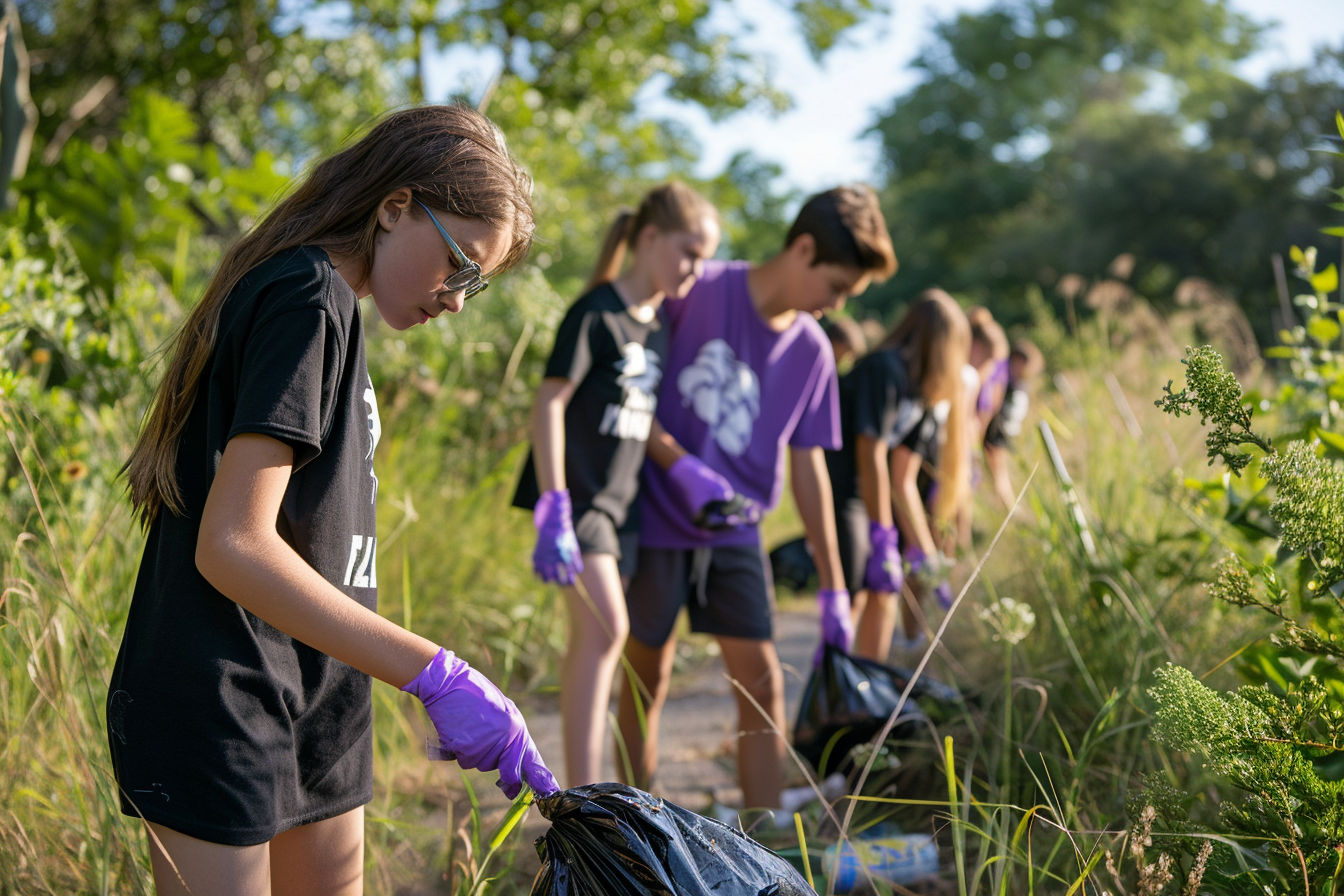Service Learning Projects: Bridging Classroom Learning with Community Impact
Service learning projects blend curriculum with community service, boosting student engagement, civic responsibility, and real-world skills.

Imagine a classroom where students are not only learning academic content but also actively engaging with their community to make a tangible difference. Service learning projects are transforming education by connecting curriculum with real-world community impact. These projects provide students with the opportunity to apply their knowledge to meaningful service activities, fostering a deeper understanding of the material and its relevance to their lives.
In today’s educational landscape, it is crucial to find ways to bridge the gap between classroom learning and practical application. Service learning projects offer a powerful solution by integrating community service with academic instruction, creating a holistic learning experience. We explore the principles, benefits, and implementation strategies of service learning projects, showcasing how they can enhance student engagement and develop critical skills. Join us as we delve into the world of service learning and discover how these initiatives can connect curriculum with community impact, empowering students to become proactive and responsible citizens.
Understanding Service Learning Projects
Service learning projects are educational experiences that integrate meaningful community service with instruction and reflection. These projects provide students with the opportunity to apply academic knowledge to real-world situations, fostering a deeper understanding of the curriculum and its relevance to their lives. Service learning projects emphasize experiential learning, community engagement, and personal growth.
Enjoy science fiction? Check out my space books HERE on Amazon!
Historically, education has focused primarily on academic achievement, often neglecting the importance of civic engagement and community involvement. However, service learning has gained recognition as a powerful pedagogical approach that bridges the gap between the classroom and the community. Core principles of service learning include experiential learning, community engagement, and curriculum integration. By embracing these principles, schools can create educational experiences that not only enhance academic learning but also foster civic responsibility and personal development.
Types of Service Learning Projects
Service learning projects can take various forms, each offering unique benefits and opportunities for student involvement. Here are some common types:
- Environmental Initiatives: Projects focused on sustainability and environmental conservation. Students can participate in activities such as tree planting, recycling programs, and community clean-ups. These initiatives help students understand the importance of environmental stewardship and the impact of their actions on the planet.
- Community Health Initiatives: Addressing public health and wellness in the community. Students can engage in health awareness campaigns, vaccination drives, and mental health support groups. These projects provide practical knowledge about health issues and promote a healthier community.
- Educational Outreach: Tutoring and mentoring programs for younger students or underserved populations. Students can help bridge educational gaps by providing academic support and mentorship. This type of service learning fosters a sense of responsibility and compassion in students.
- Community Development: Projects aimed at improving local infrastructure and resources. Students can participate in building community gardens, renovating public spaces, and creating art installations. These projects enhance the quality of life in the community and teach students about civic engagement.
- Cultural Preservation: Initiatives to document and preserve local history and cultural heritage. Students can work on projects such as oral history recordings, museum exhibits, and cultural festivals. These activities promote cultural awareness and pride in the community.
By exploring these types of service learning projects, schools can create diverse and impactful educational experiences.
Benefits of Service Learning Projects
Service learning projects offer numerous advantages, making them a valuable addition to educational practices. Here are some key benefits:
- Enhanced Academic Learning: Reinforcing curriculum content through real-world applications. Service learning helps students see the relevance of their studies and deepens their understanding of academic concepts.
- Increased Civic Engagement: Fostering a sense of responsibility and commitment to the community. Students become more aware of community issues and motivated to make a positive impact.
- Skill Development: Building critical thinking, problem-solving, and interpersonal skills. Service learning projects require students to collaborate, communicate effectively, and think critically about complex issues.
- Strengthened School-Community Relationships: Creating partnerships and collaborative opportunities. Service learning fosters connections between schools and their communities, leading to mutual benefits and support.
- Personal Growth and Development: Encouraging empathy, self-awareness, and personal responsibility. Through service learning, students develop a sense of empathy and learn to take responsibility for their actions and contributions to society.
By understanding these benefits, educators and administrators can better appreciate the value of integrating service learning projects into their schools.
Implementing Service Learning Projects
Implementing service learning projects requires careful planning and collaboration. The first step is identifying community needs by collaborating with community partners to find relevant projects. Understanding the community’s priorities ensures that the projects are meaningful and impactful.
Aligning the projects with the curriculum is crucial. Ensuring that service learning activities are integrated with academic goals and standards helps reinforce classroom learning and makes the projects more educational. Planning and preparation are essential. Developing clear objectives, timelines, and resource requirements ensures that the projects are well-organized and achievable. Effective planning also involves addressing logistical issues such as transportation and scheduling.
Student involvement is key to the success of service learning projects. Engaging students in the planning and decision-making process fosters a sense of ownership and commitment. When students take an active role, they are more likely to be motivated and invested in the projects. Assessment and reflection are important components. Evaluating project outcomes and incorporating student reflections help measure the impact of the projects and provide valuable insights for future improvements. Reflection activities also enhance learning by encouraging students to think critically about their experiences.
By following these steps, schools can successfully implement service learning projects that benefit both students and the community.
Overcoming Challenges in Service Learning Projects
Implementing service learning projects comes with its own set of challenges, but these can be effectively managed with strategic planning and collaboration. Logistical issues such as transportation, scheduling, and resource needs require careful coordination. Schools can address these challenges by planning well in advance and seeking support from community partners.
Ensuring student safety is paramount. Implementing safety protocols and guidelines helps protect students during service activities. Clear communication of these protocols to students and parents is essential. Balancing academic and service goals is important. Maintaining a strong connection between service activities and curriculum objectives ensures that the projects are educationally valuable. Teachers should integrate service learning into their lesson plans and assessments.
Sustaining engagement over the long term involves keeping students motivated and committed. Recognizing and celebrating students' contributions and successes helps maintain enthusiasm and interest. Community partnership management is crucial. Building and maintaining strong relationships with community partners involves regular communication, mutual respect, and collaboration.
By addressing these challenges, schools can create a supportive and effective environment for service learning projects.
Case Studies
Implementing service learning projects has led to notable successes in various educational settings across the country. Here are three case studies highlighting the impact of these methods:
Case Study 1: Environmental Initiative in an Oregon High School
A high school in Oregon launched an environmental initiative focused on sustainability. Students participated in activities such as tree planting, recycling programs, and community clean-ups. The initiative helped students understand the importance of environmental stewardship and fostered a sense of responsibility towards the planet. The project also strengthened the school's relationship with local environmental organizations.
Case Study 2: Community Health Initiative in an Ohio Middle School
An Ohio middle school implemented a community health initiative aimed at promoting public health and wellness. Students engaged in health awareness campaigns, vaccination drives, and mental health support groups. The project provided students with practical knowledge about health issues and promoted a healthier community. The initiative also enhanced students' communication and organizational skills.
Case Study 3: Cultural Preservation Project in a Louisiana Elementary School
An elementary school in Louisiana undertook a cultural preservation project to document and preserve local history and cultural heritage. Students worked on oral history recordings, museum exhibits, and cultural festivals. The project promoted cultural awareness and pride in the community. It also provided students with opportunities to develop research, communication, and presentation skills.
Practical Tips for Educators and Administrators
Implementing service learning projects can be straightforward with the right approach. Here are some practical tips for educators and administrators to consider:
- Start with Small Projects: Begin with manageable projects to build confidence and experience. Starting small allows for adjustments based on initial feedback and results.
- Leverage Community Resources: Utilize local organizations and experts for support and guidance. Community partners can provide valuable resources and expertise.
- Foster Student Leadership: Encourage students to take ownership and lead projects. Empowering students fosters a sense of responsibility and commitment.
- Integrate Reflection Activities: Incorporate regular reflection sessions to deepen learning and personal growth. Reflection helps students connect their experiences to academic concepts and personal development.
- Celebrate Achievements: Recognize and celebrate the contributions and successes of students and community partners. Celebrating achievements fosters a positive and motivating environment.
These tips can help educators and administrators create successful and sustainable service learning projects.
Future Trends in Service Learning Projects
The future of service learning projects is evolving, with new trends enhancing their effectiveness and reach. Digital service learning is becoming increasingly popular, using technology to connect with global communities and support virtual projects. These digital initiatives broaden the scope of service learning and provide opportunities for global collaboration.
Interdisciplinary projects are gaining traction. Combining multiple subjects to create holistic learning experiences enhances student engagement and provides a well-rounded education. A focus on sustainability is another emerging trend. Emphasizing long-term impact and sustainable practices ensures that service learning projects contribute positively to the community and the environment.
Check out our engaging printable posters. CLICK HERE to explore!
Global collaboration is expanding. Partnering with international communities for broader perspectives fosters global awareness and cross-cultural communication. Student-led initiatives are also on the rise. Increasing opportunities for students to design and lead their own projects empowers them to take charge of their learning and community involvement.
By staying updated with these trends, schools can continue to innovate and provide high-quality service learning projects for students.
Conclusion
Service learning projects offer a unique opportunity to connect curriculum with real-world community impact. By integrating meaningful community service with academic learning, these projects enhance student engagement, foster civic responsibility, and develop critical skills.
As education evolves, it is essential for schools to embrace service learning projects to prepare students for the complexities of the modern world. Addressing challenges such as logistics, safety, and sustained engagement requires strategic planning and collaboration. By leveraging future trends like digital service learning and global collaboration, schools can create impactful and sustainable service learning programs that benefit both students and communities. Engaging students in service learning not only enriches their educational experience but also empowers them to become proactive, responsible, and compassionate members of society.
Check out some of my latest science fiction books HERE on Amazon!
Transform your classroom into an inspiring and vibrant learning space with our beautifully designed printable posters! Perfect for engaging your students and enhancing your teaching environment, our poster bundles cover everything from historical philosophers to animals. CLICK HERE to explore our exclusive collections on Teachers Pay Teachers and give your students the motivational boost they need!
